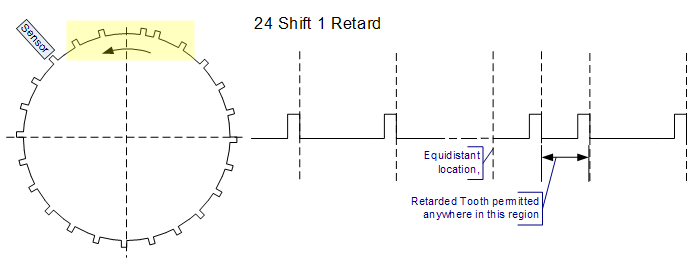 |
The N teeth with 1 retarded encoder style describes those encoder patterns that consist of N equidistant teeth distributed about a wheel with one of those teeth retarded relative to the direction of rotation. The retarded tooth is retarded by half a tooth or more between the equidistant location and the next tooth. Thus this would be > 15+7.5° and < 30° if 'N' was 24. The example is depicted in the figure and is referred to as a 24 Retarded 1 encoder.

The non-equidistant spacing is used to communicate synchronization information. Speaking generally, the retared tooth is detected if the tooth period is less than half the previous tooth period.
A crank synchronization error will be flagged if, upon detecting the retarded tooth, the number of real teeth previously observed was incorrect. Thus the 24 Retarded 1 pattern would issue a synchronization error if 23 normal teeth were not observed between observing the "retarded" tooth and observing the next "retarded" tooth.
Note: The encoder operates by inserting a pseudo tooth at the equally spaced location, in a similar manner to missing tooth encoders. Tooth Period (rpm) is adjusted appropriately such that period reflects the location of the pseudo tooth, and the retarded tooth has no impact on period calculation. However prior to synchronisation, the actual tooth period prior and post the retarded tooth are reported. Therefore instantaneous rpm cannot be relied upon prior to synchronisation.
A resynchronization can temporarily impact the behavior of crank-synchronous blocks. Impacts include a pulse not scheduling as expected, having it occur twice, or being malformed. The system will recover, but the initial impact is unavoidable because the correction to the crank angle position results in a step change in position that may disrupt the underlying pulse scheduling software.
| Copyright 2010 Woodward Corporation. All Rights Reserved. | Visit Us: mcs.woodward.com |